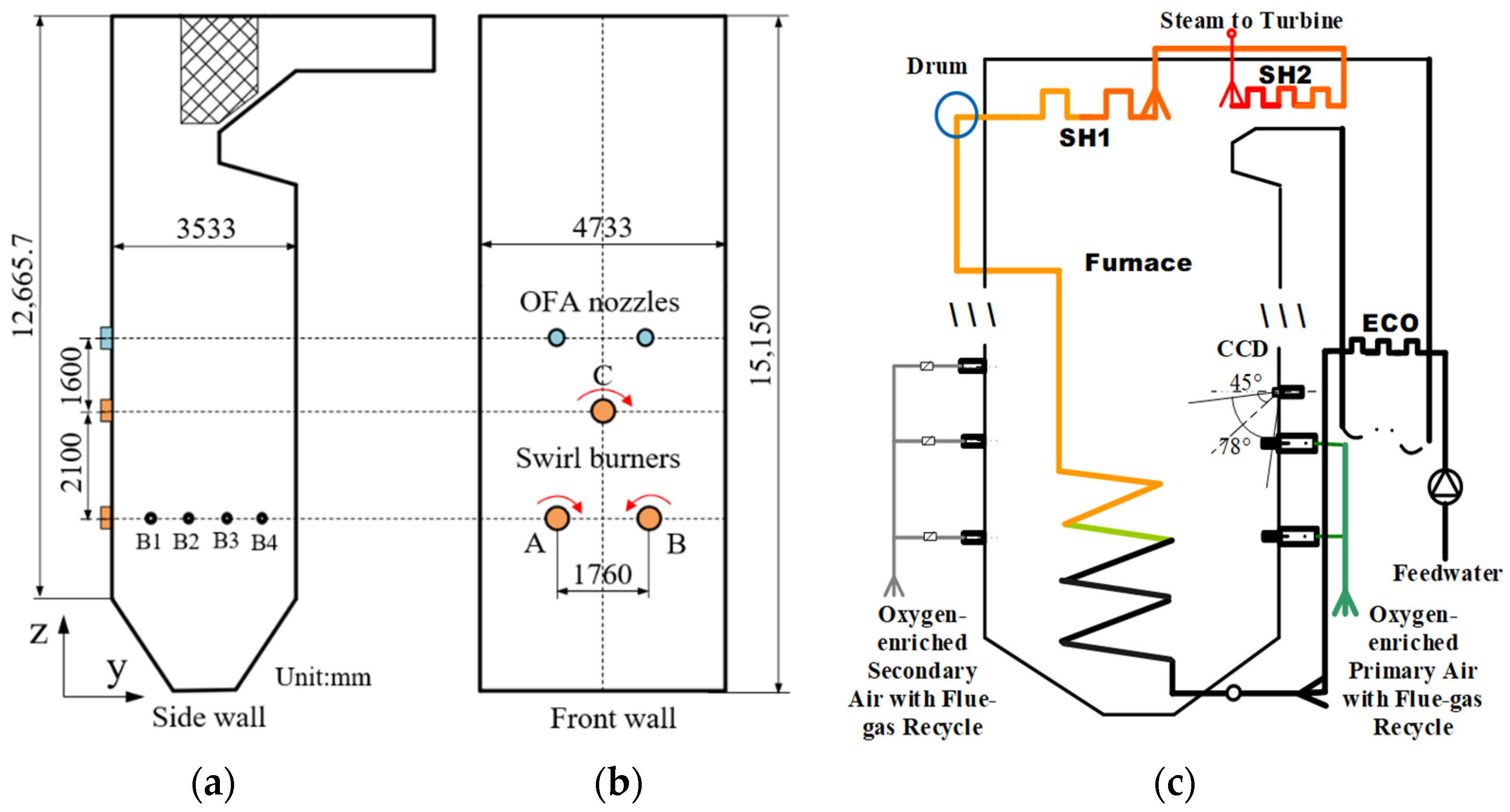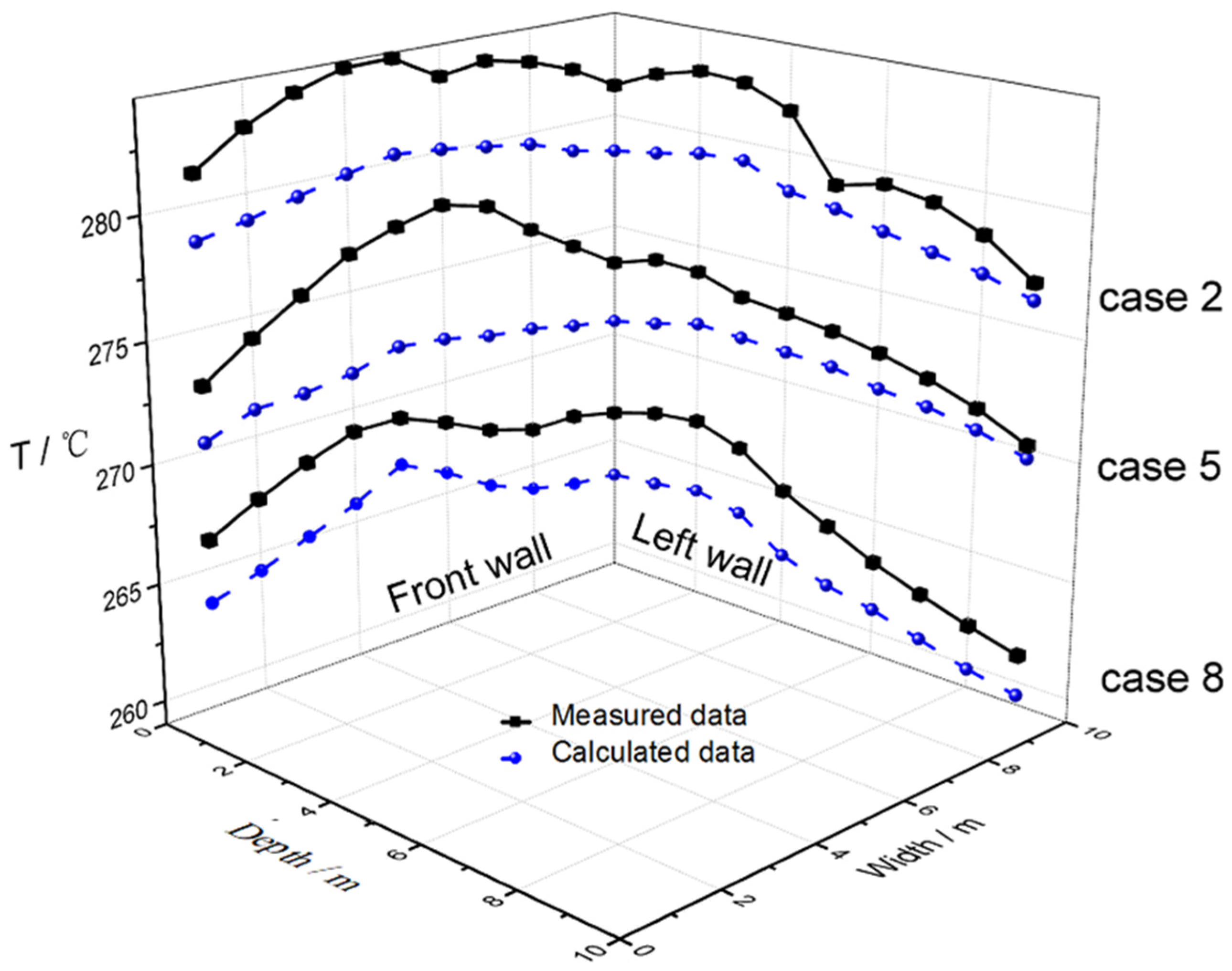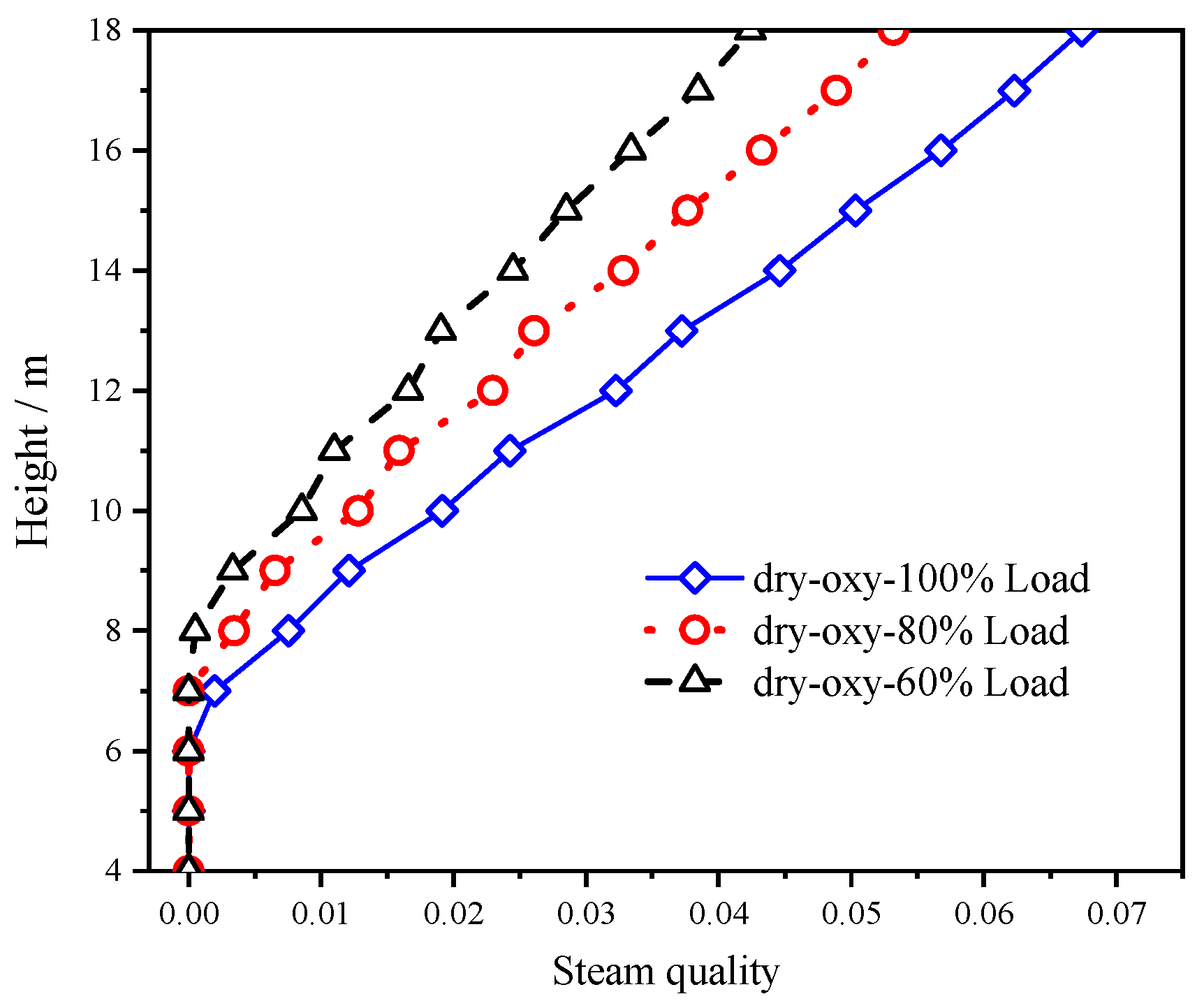Decoupling Investigation of Furnace Side and Evaporation System in a Pulverized-Coal Oxy-Fuel Combustion Boiler
Abstract
:1. Introduction
2. Materials and Methods
2.1. Numerical Simulation of Oxy-Fuel Combustion Boiler
2.2. Distributed Mathematical Model
3. Results and Discussion
4. Conclusions
- (1)
- A distribution parameter model for the evaporation system was developed in a 35 MW natural circulation air/oxy-fuel combustion boiler. Comparing the calculated value of the wall temperature with the measured value, it was found that the maximum relative error was 2.14%, which was located at the width of 2.58 m under the condition of oxy-fuel dry FGR combustion at 80% load, and the error was within a reasonable range. Therefore, the model proposed in this paper can produce correct predictions.
- (2)
- When compared to the conventional air combustion, the water wall heat flux in the oxy-fuel dry/wet FGR combustion conditions remained even and uniform at the same load due to the changes of the specific heat, the diffusion, and the radiation coefficient of the three atomic gases (CO2 and H2O). The flue gas temperature in the oxy-fuel wet FGR combustion was much higher than that in the dry FGR situation, and the metal temperature in the oxy-fuel dry FGR condition was lower than that in other two operation modes. Therefore, the wall heat flux distribution and the wall temperature distribution of the oxy-fuel dry FGR combustion were the most uniform and reasonable.
- (3)
- This subject effectively integrated the numerical simulation information of the furnace side with the thermal system model of the boiler side, and the research results provided novel guidance for the design, operation, and diagnosis of large capacity oxy-fuel combustion boilers.
Author Contributions
Funding
Conflicts of Interest
Nomenclature
| specific isobaric heat capacity | |
| diameter | |
| mass flow rate | |
| flow area | |
| acceleration of gravity | |
| mass velocity | |
| specific enthalpy | |
| height | |
| mass | |
| Nusselt number | |
| pressure | |
| Prandtl number | |
| heat flux | |
| heat flow rate | |
| Reynolds number | |
| surface area | |
| absolute temperature | |
| specific internal energy | |
| volume | |
| steam quality | |
| Martinelli number | |
| latent heat of vaporization | |
| heat conductivity coefficient | |
| F | Reynolds factor |
| Greek symbols | |
| heat transfer coefficient | |
| frictional resistance coefficient | |
| difference in any quantity | |
| emissivity | |
| absorption coefficient | |
| thermal conductivity | |
| dynamic viscosity | |
| resistance coefficient | |
| density | |
| Stefan-Boltzmann constant | |
| velocity | |
| Subscripts | |
| number of element | |
| liquid | |
| G | gas |
| maximum value | |
| inner | |
| outer | |
| water wall | |
| saturation | |
| inlet | |
| outlet | |
References
- Li, S.; Xu, Y.; Gao, Q. Measurements and modelling of oxy-fuel coal combustion. Proc. Combust. Inst. 2019, 37, 2643–2661. [Google Scholar] [CrossRef]
- Guo, J.; Liu, Z.; Wang, P.; Huang, X.; Li, J.; Xu, P.; Zheng, C. Numerical investigation on oxy-combustion characteristics of a 200MWe tangentially fired boiler. Fuel 2015, 140, 660–668. [Google Scholar] [CrossRef]
- Nakod, P.; Krishnamoorthy, G.; Sami, M.; Orsino, S. A comparative evaluation of gray and non-gray radiation modeling strategies in oxy-coal combustion simulations. Appl. Therm. Eng. 2013, 54, 422–432. [Google Scholar] [CrossRef]
- Black, S.; Szuhánszki, J.; Pranzitelli, A.; Ma, L.; Stanger, P.; Ingham, D.; Pourkashanian, M. Effects of firing coal and biomass under oxy-fuel conditions in a power plant boiler using CFD modelling. Fuel 2013, 113, 780–786. [Google Scholar] [CrossRef]
- Gani, Z.F.A.; Pandian, P.A. Modelling of coal combustion in a drop tube furnace in air and oxy fuel environment. Mater. Today Proc. 2021, 47, 4431–4437. [Google Scholar] [CrossRef]
- Ahn, J.; Kim, H.-J. Combustion characteristics of 0.5 MW class oxy-fuel FGR (Flue Gas Recirculation) boiler for CO2 capture. Energies 2021, 14, 4333. [Google Scholar] [CrossRef]
- De Kerret, F.; Béguin, C.; Etienne, S. Two-phase flow pattern identification in a tube bundle based on void fraction and pressure measurements, with emphasis on churn flow. Int. J. Multiph. Flow 2017, 94, 94–106. [Google Scholar] [CrossRef]
- Guzella, M.; Czelusniak, L.; Mapelli, V.; Alvariño, P.; Ribatski, G.; Cabezas-Gómez, L. Simulation of boiling heat transfer at different reduced temperatures with an improved pseudopotential lattice boltzmann method. Symmetry 2020, 12, 1358. [Google Scholar] [CrossRef]
- Weise, S.; Dietrich, B.; Wetzel, T. Flow-pattern based prediction of flow boiling heat transfer in horizontal tubes with circumferentially varying heat flux. Int. J. Heat Mass Transf. 2020, 148, 119018. [Google Scholar] [CrossRef]
- Wu, J.; Li, X.; Liu, H.; Zhao, K.; Liu, S. Calculation method of gas–liquid two-phase boiling heat transfer in helically-coiled tube based on separated phase flow model. Int. J. Heat Mass Transf. 2020, 161, 120242. [Google Scholar] [CrossRef]
- Zheng, J.X.; Chen, T.K.; Chen, X.J.; Yang, D. Dynamic thermal-hydraulic models for single-phase heated tubes. Adv. Mech. 1997, 27, 538–547. [Google Scholar]
- Li, H.; Huang, X.; Zhang, L. A lumped parameter dynamic model of the helical coiled once-through steam generator with movable boundaries. Nucl. Eng. Des. 2008, 238, 1657–1663. [Google Scholar] [CrossRef]
- Yu, T.; Yuan, J. Evaporation system modeling of the utility boiler aiming at real-time estimation of the heat flux into water walls. IFAC Proc. Vol. 2013, 46, 581–584. [Google Scholar] [CrossRef]
- Laubscher, R.; Rousseau, P. CFD study of pulverized coal-fired boiler evaporator and radiant superheaters at varying loads. Appl. Therm. Eng. 2019, 160, 114057. [Google Scholar] [CrossRef]
- Tang, G.; Zhang, M.; Gu, J.; Wu, Y.; Yang, H.; Zhang, Y.; Wei, G.; Lyu, J. Thermal-hydraulic calculation and analysis on evaporator system of a 660 MWe ultra-supercritical CFB boiler. Appl. Therm. Eng. 2019, 151, 385–393. [Google Scholar] [CrossRef]
- Chu, Y.-T.; Lou, C.; Cheng, Q.; Zhou, H.-C. Distributed parameter modeling and simulation for the evaporation system of a controlled circulation boiler based on 3-D combustion monitoring. Appl. Therm. Eng. 2008, 28, 164–177. [Google Scholar] [CrossRef]
- Zheng, S.; Luo, Z.; Zhang, X.; Zhou, H. Distributed parameters modeling for evaporation system in a once-through coal-fired twin-furnace boiler. Int. J. Therm. Sci. 2011, 50, 2496–2505. [Google Scholar] [CrossRef]
- Shu, Z.; Zixue, L.; Yanxiang, D.; Huaichun, Z. Development of a distributed-parameter model for the evaporation system in a supercritical W-shaped boiler. Appl. Therm. Eng. 2014, 62, 123–132. [Google Scholar] [CrossRef]
- Laubscher, R.; van der Merwe, S. Heat transfer modelling of semi-suspension biomass fired industrial watertube boiler at full- and part-load using CFD. Therm. Sci. Eng. Prog. 2021, 25, 100969. [Google Scholar] [CrossRef]
- Laubscher, R.; De Villiers, E. Integrated mathematical modelling of a 105 t/h biomass fired industrial watertube boiler system with varying fuel moisture content. Energy 2021, 228, 120537. [Google Scholar] [CrossRef]
- Guo, J.; Liu, Z.; Huang, X.; Zhang, T.; Luo, W.; Hu, F.; Li, P.; Zheng, C. Experimental and numerical investigations on oxy-coal combustion in a 35 MW large pilot boiler. Fuel 2017, 187, 315–327. [Google Scholar] [CrossRef]










| Proximate Analysis/% | Ultimate Analysis/% | Qnet,ar/(MJ/kg) | |||||||
|---|---|---|---|---|---|---|---|---|---|
| Mar | Aar | Var | FCar | Sar | Nar | Car | Har | Oar | 21.53 |
| 9.22 | 22.77 | 16.93 | 51.08 | 0.32 | 0.50 | 54.14 | 3.65 | 9.40 | |
| Items | Velocity, m/s | ||||||||
|---|---|---|---|---|---|---|---|---|---|
| 60% Load | 80% Load | 100% Load | |||||||
| Air/1 | Dry FGR/2 | Wet FGR/3 | Air/4 | Dry FGR/5 | Wet FGR/6 | Air/7 | Dry FGR/8 | Wet FGR/9 | |
| Prim. air | 12.8 | 11.0 | 11.0 | 17.1 | 14.6 | 14.9 | 23.0 | 20.0 | 20.4 |
| Sec. air | 18.9 | 17.8 | 18.0 | 25.3 | 23.7 | 25.0 | 37.0 | 38.6 | 40.0 |
| OFA | 22.9 | 0 | 0 | 30.6 | 0 | 0 | 32.2 | 0 | 0 |
| Cool. air | 4.8 | 4.8 | 4.8 | 7.2 | 7.2 | 7.2 | 8.8 | 11.1 | 11.4 |
| Case | Load/MW | Feedwater Pres./MPa | Feedwater Temp/°C | Feedwater Flow/(t/h) |
|---|---|---|---|---|
| 1/2/3 | 21 | 4.59 | 103 | 24.37 |
| 4/5/6 | 28 | 6.13 | 105 | 32.44 |
| 7/8/9 | 35 | 7.66 | 112 | 38.50 |
| Air-Fired | Dry FGR | Wet FGR | |||||||
|---|---|---|---|---|---|---|---|---|---|
| Case | 1 | 4 | 7 | 2 | 5 | 8 | 3 | 6 | 9 |
| Heat flux/(W/m2) | 104.78 | 117.52 | 136.03 | 96.94 | 110.99 | 125.52 | 106.63 | 119.58 | 138.71 |
| Water wall temperature/°C | 267.99 | 271.03 | 279.45 | 263.66 | 269.47 | 276.94 | 268.43 | 271.47 | 280.22 |
Publisher’s Note: MDPI stays neutral with regard to jurisdictional claims in published maps and institutional affiliations. |
© 2022 by the authors. Licensee MDPI, Basel, Switzerland. This article is an open access article distributed under the terms and conditions of the Creative Commons Attribution (CC BY) license (https://creativecommons.org/licenses/by/4.0/).
Share and Cite
Luo, Z.; Feng, Z.; Wu, B.; Cheng, Q. Decoupling Investigation of Furnace Side and Evaporation System in a Pulverized-Coal Oxy-Fuel Combustion Boiler. Energies 2022, 15, 2354. https://doi.org/10.3390/en15072354
Luo Z, Feng Z, Wu B, Cheng Q. Decoupling Investigation of Furnace Side and Evaporation System in a Pulverized-Coal Oxy-Fuel Combustion Boiler. Energies. 2022; 15(7):2354. https://doi.org/10.3390/en15072354
Chicago/Turabian StyleLuo, Zixue, Zixuan Feng, Bo Wu, and Qiang Cheng. 2022. "Decoupling Investigation of Furnace Side and Evaporation System in a Pulverized-Coal Oxy-Fuel Combustion Boiler" Energies 15, no. 7: 2354. https://doi.org/10.3390/en15072354
APA StyleLuo, Z., Feng, Z., Wu, B., & Cheng, Q. (2022). Decoupling Investigation of Furnace Side and Evaporation System in a Pulverized-Coal Oxy-Fuel Combustion Boiler. Energies, 15(7), 2354. https://doi.org/10.3390/en15072354






